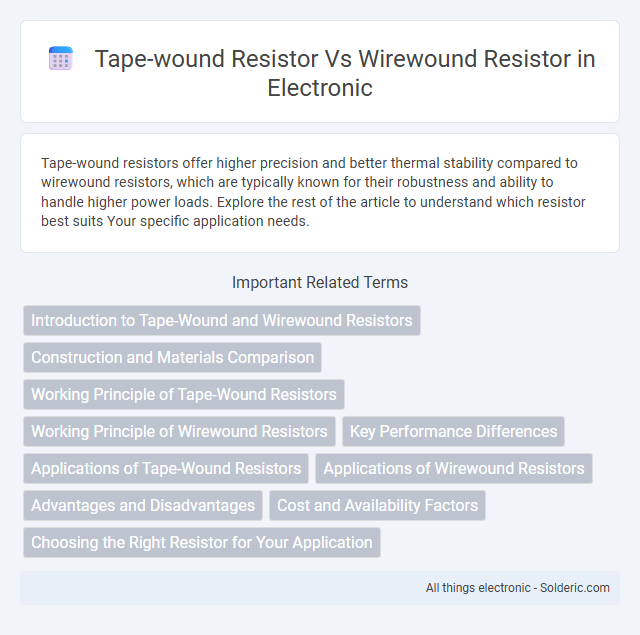Tape-wound resistors offer higher precision and better thermal stability compared to wirewound resistors, which are typically known for their robustness and ability to handle higher power loads. Explore the rest of the article to understand which resistor best suits Your specific application needs.
Comparison Table
| Feature | Tape-Wound Resistor | Wirewound Resistor |
|---|---|---|
| Construction | Resistive element wound on ceramic tape | Resistive wire wound around a core |
| Power Rating | Typically up to 10W | Up to several hundred watts |
| Precision | High precision, low tolerance | Moderate precision, usually +-1% |
| Temperature Coefficient | Low TCR (+-50 ppm/degC) | Higher TCR (+-100 ppm/degC or more) |
| Inductance | Very low inductance | Significant inductance due to coil structure |
| Applications | Precision circuits, low noise applications | High power dissipation, load testing |
| Cost | Higher cost due to precision manufacturing | Generally lower cost |
Introduction to Tape-Wound and Wirewound Resistors
Tape-wound resistors and wirewound resistors both serve as precision components designed to handle high power and provide accurate resistance values. Tape-wound resistors use a thin metal alloy tape wound around an insulating core, offering low inductance and stable performance, while wirewound resistors consist of a resistive wire coiled on a ceramic or fiberglass core, which can introduce higher inductance but typically allows for higher power dissipation. Your selection between these resistor types depends on the specific electrical characteristics, power rating, and frequency response required for your application.
Construction and Materials Comparison
Tape-wound resistors are constructed by tightly winding a thin metal alloy tape around an insulating core, providing precise resistance values and excellent stability due to uniform heat dissipation. Wirewound resistors consist of a wire, often nickel-chromium or constantan, wound around a ceramic, fiberglass, or plastic core, offering high power handling but with potential inductance effects. Your choice between the two depends on the required tolerance, power rating, and frequency response for the application.
Working Principle of Tape-Wound Resistors
Tape-wound resistors operate by tightly winding a resistive metal tape, such as nickel-chromium alloy, around an insulating core to provide precise resistance and improved heat dissipation. The design offers high pulse load capacity and stability under thermal stress, differentiating it from wirewound resistors, which use a wire coil and may exhibit inductive reactance. Understanding the working principle of tape-wound resistors helps you select components ideal for high-power and high-frequency applications where accuracy and reliability are critical.
Working Principle of Wirewound Resistors
Wirewound resistors operate by coiling a metal wire, typically nichrome or copper-nickel alloy, around a ceramic, glass, or fiberglass core to create resistance through the wire's inherent resistivity. The electrical current flowing through the wire generates heat, which the resistor dissipates efficiently due to the materials' thermal conductivity. Understanding this working principle helps you select the appropriate resistor type for high-precision and high-power applications where stability and reliability are critical.
Key Performance Differences
Tape-wound resistors offer higher power dissipation and better thermal stability compared to wirewound resistors, making them ideal for precision applications requiring low inductance. Wirewound resistors typically provide superior accuracy in high-frequency circuits but exhibit higher inductance and slower thermal response. Your choice depends on whether thermal management or frequency performance is the primary concern.
Applications of Tape-Wound Resistors
Tape-wound resistors are commonly used in precision electronic circuits requiring low noise, stable resistance, and high power dissipation, such as in audio equipment, medical devices, and industrial control systems. Their construction provides excellent pulse load and thermal shock resistance, making them ideal for applications involving rapid current changes or fluctuating environmental conditions. Compared to wirewound resistors, tape-wound resistors offer improved frequency response and reduced inductance, enhancing performance in sensitive analog and measurement circuits.
Applications of Wirewound Resistors
Wirewound resistors are ideal for high-power applications requiring precise resistance values and excellent stability, such as in power supplies, audio equipment, and motor control systems. Their ability to handle high energy pulses and maintain low noise makes them suitable for industrial equipment and measurement devices. You can rely on wirewound resistors for applications that demand durability and accuracy under harsh conditions.
Advantages and Disadvantages
Tape-wound resistors offer high stability and precision with minimal inductance, making them ideal for high-frequency and precision applications, whereas wirewound resistors provide excellent power dissipation and durability but exhibit higher inductance which can limit performance in AC circuits. Tape-wound resistors are advantageous in compact electronic designs due to their smaller size and reduced electromagnetic interference, but they generally have lower power ratings compared to wirewound resistors. Wirewound resistors excel in high-power applications and harsh environments, yet their construction can lead to audible noise and less precision under variable temperature conditions.
Cost and Availability Factors
Tape-wound resistors generally offer lower cost and easier availability compared to wirewound resistors, making them suitable for budget-sensitive projects. Wirewound resistors, known for their precision and superior heat dissipation, tend to be more expensive and less commonly stocked in general electronic component inventories. Your choice between the two should consider these cost and supply differences alongside performance requirements.
Choosing the Right Resistor for Your Application
Tape-wound resistors offer high pulse load capacity and low inductance, making them ideal for high-frequency and power-sensitive applications, while wirewound resistors provide precise resistance and excellent stability in high-current and high-temperature environments. Selecting the right resistor depends on factors like power rating, tolerance, frequency response, and thermal management requirements. For applications requiring minimal inductance and fast transient response, tape-wound resistors are preferable, whereas wirewound resistors excel in heavy-duty power regulation and current sensing.
Tape-wound resistor vs wirewound resistor Infographic

 solderic.com
solderic.com